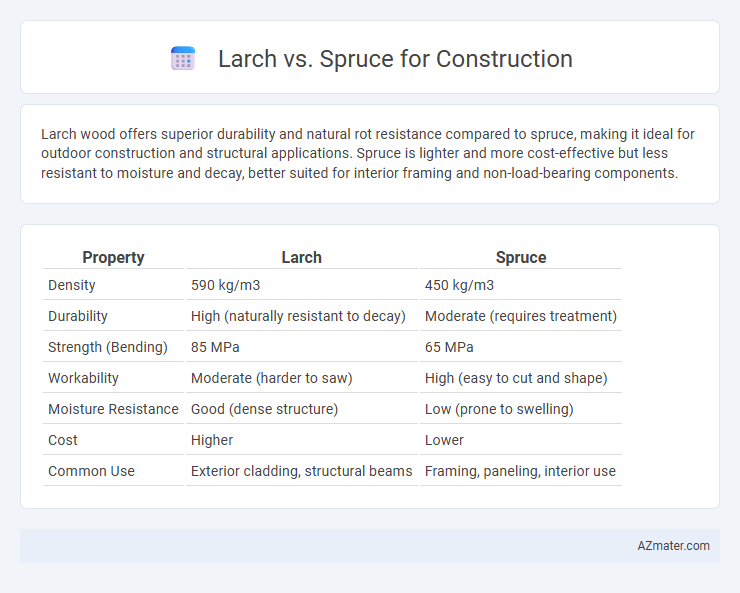Larch wood offers superior durability and natural rot resistance compared to spruce, making it ideal for outdoor construction and structural applications. Spruce is lighter and more cost-effective but less resistant to moisture and decay, better suited for interior framing and non-load-bearing components.
Table of Comparison
| Property | Larch | Spruce |
|---|---|---|
| Density | 590 kg/m3 | 450 kg/m3 |
| Durability | High (naturally resistant to decay) | Moderate (requires treatment) |
| Strength (Bending) | 85 MPa | 65 MPa |
| Workability | Moderate (harder to saw) | High (easy to cut and shape) |
| Moisture Resistance | Good (dense structure) | Low (prone to swelling) |
| Cost | Higher | Lower |
| Common Use | Exterior cladding, structural beams | Framing, paneling, interior use |
Introduction: Larch vs Spruce in Construction
Larch and spruce are two popular softwoods widely used in construction, each offering distinct advantages based on durability and strength. Larch is renowned for its natural rot resistance and hardness, making it ideal for exterior structures and heavy-duty applications. Spruce, valued for its lightweight and ease of workability, is commonly used in framing, paneling, and interior construction where cost efficiency and flexibility are priorities.
Botanical Characteristics of Larch and Spruce
Larch (Larix spp.) is a deciduous conifer with needle-like leaves that turn golden and drop in autumn, differing from the evergreen spruce (Picea spp.) which retains sharp, four-sided needles year-round. Larch wood is dense and resinous, offering excellent natural durability, while spruce features softer, lighter wood valued for its strength-to-weight ratio. These botanical differences influence their suitability in construction, with larch used for outdoor and heavy-duty applications and spruce preferred for framing and interior structures.
Wood Density and Strength Comparison
Larch wood exhibits a higher density, typically around 590-700 kg/m3, compared to spruce, which ranges from 400-500 kg/m3, resulting in superior strength and durability for structural applications. Larch's dense grain structure offers enhanced resistance to compression and bending stresses, making it ideal for load-bearing elements. Spruce, while lighter and easier to work with, provides sufficient strength for framing but lacks the robustness of larch in heavy-duty construction.
Durability and Decay Resistance
Larch wood is highly valued in construction for its exceptional durability and natural decay resistance, making it ideal for outdoor structures and heavy-duty applications. Spruce, while commonly used due to its lightweight and workability, has lower resistance to decay and requires treatment for prolonged exposure to moisture and pests. The dense grain structure of larch contributes to its superior longevity compared to spruce, which is more prone to rot under harsh environmental conditions.
Workability and Ease of Processing
Larch wood offers superior workability for construction due to its dense, straight grain, which allows for clean cuts and smooth finishes, reducing tool wear. Spruce is lighter and softer, making it easier to saw and shape but more prone to denting and surface imperfections during processing. The choice between Larch and Spruce depends on the balance between durability needs and the ease of machining for specific construction applications.
Moisture Resistance and Dimensional Stability
Larch wood exhibits superior moisture resistance compared to spruce, making it a preferred choice for outdoor and damp environments due to its dense, resin-rich composition that repels water effectively. Spruce, while lighter and easier to work with, tends to absorb moisture more readily, leading to greater dimensional changes such as swelling and warping. Consequently, larch offers enhanced dimensional stability in construction applications where exposure to moisture is a critical concern.
Cost and Availability of Larch vs Spruce
Larch wood typically costs more than spruce due to its greater durability and natural resistance to decay, making it a preferred choice for exterior and structural applications. Spruce is widely available and more affordable, commonly used for interior framing and non-load-bearing structures because of its lighter weight and easier workability. The availability of spruce in large quantities from sustainable plantations ensures consistent supply, whereas larch is less abundant and often sourced from natural forests, impacting both price and accessibility.
Common Construction Applications
Larch wood is highly valued in construction for its natural durability and resistance to decay, making it an ideal choice for outdoor applications such as decking, cladding, and structural beams. Spruce, known for its lightweight strength and consistent grain, is frequently used in framing, interior paneling, and plywood production. Both species provide excellent workability, but larch's superior resistance makes it better suited for exposed elements, while spruce excels in indoor or protected environments.
Sustainability and Environmental Impact
Larch wood is prized for its natural durability and resistance to decay, making it a sustainable choice with fewer chemical treatments required compared to spruce. Spruce, while faster growing and abundant, often needs chemical preservation to enhance longevity, which can impact environmental safety. Choosing larch contributes to lower ecological footprints in construction due to its longevity and minimal processing.
Conclusion: Choosing Between Larch and Spruce for Construction
Larch offers superior durability and natural resistance to rot, making it ideal for outdoor and heavy-duty construction projects. Spruce provides a lighter, more cost-effective option that is easier to work with for interior framing and general construction. Selecting between larch and spruce depends on project requirements, budget, and environmental exposure.

Infographic: Larch vs Spruce for Construction
 azmater.com
azmater.com